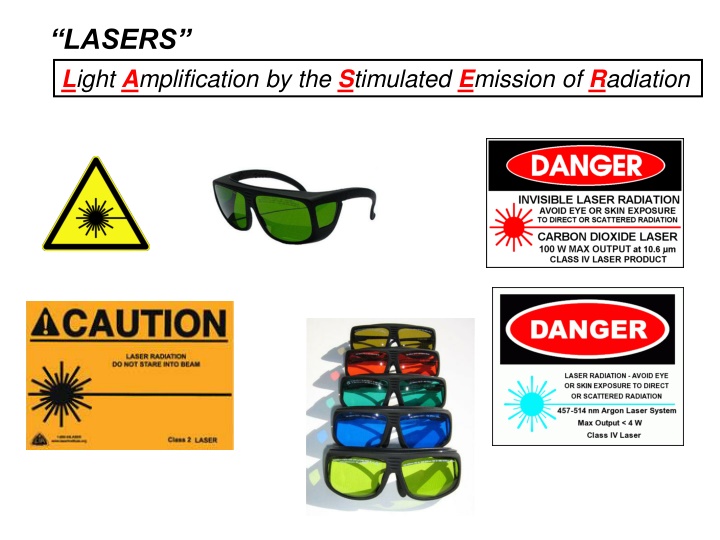
Fascinating History and Applications of Lasers
Explore the rich history and diverse applications of lasers, from Albert Einstein's pioneering work to modern advancements in laser technology such as laser cutting and laser welding. Learn about different types of lasers and their roles in various industries, including medicine, manufacturing, and astronomy. Discover how lasers have revolutionized our world and continue to drive innovation across different fields.
Download Presentation

Please find below an Image/Link to download the presentation.
The content on the website is provided AS IS for your information and personal use only. It may not be sold, licensed, or shared on other websites without obtaining consent from the author. If you encounter any issues during the download, it is possible that the publisher has removed the file from their server.
You are allowed to download the files provided on this website for personal or commercial use, subject to the condition that they are used lawfully. All files are the property of their respective owners.
The content on the website is provided AS IS for your information and personal use only. It may not be sold, licensed, or shared on other websites without obtaining consent from the author.
E N D
Presentation Transcript
LASERS Light Amplification by the Stimulated Emission of Radiation File:DIN 4844-2 Warnung vor Laserstrahl D-W010.svg
LASERS .. small File:Diode laser.jpg Tunable Diode Laser - about 2mm x 2mm chip - used to measure water vapor concentration in the near-IR - used to detect low-levels of gas concentration (ppm, ppb)
LASERS .. Large!!! http://en.wikipedia.org/wiki/File:NOVA_laser.jpg NOVA Laser at LLNL
http://en.wikipedia.org/wiki/File:Lying_down_on_the_VLT_platform.jpghttp://en.wikipedia.org/wiki/File:Lying_down_on_the_VLT_platform.jpg LASERS Laser Guide Stars - VLT 8.2m telescopes - creates an artificial star at an altitude of 90 km -yellow sodium line - part of the VLT s Adaptive Optics system
http://en.wikipedia.org/wiki/File:Laser_cutting_CAD_and_physical_part.pnghttp://en.wikipedia.org/wiki/File:Laser_cutting_CAD_and_physical_part.png LASERS Laser Cutting Lasercutting-video.ogg CO2, Nd:YAG E 1MW/cm2 fbeam < .5mm carbon steel, stainless steel, aluminum, titanium http://en.wikipedia.org/wiki/File:Lasercutting-video.ogg Laser Welding Remote Fibre Laser Welding WMG Warwick.ogg top: CAD model http://en.wikipedia.org/wiki/File:Remote_Fibre_Laser_Welding_WMG_Warwick.ogg bottom: laser-cut part - 0.5mm thick stainless steel
LASERS .. History 1917--Albert Einstein describes the photon and points out that stimulated emission of light could occur. 1958--Arthur Schawlow and Charles Townes publish their theoretical paper "Infrared and Optical Masers" in Physical Review, 1958. 1960 --Theodore Maiman invents the first laser, the optical version of the maser, using a man-made ruby crystal. First operated on May 16, 1960. 1961--HeNe gas laser is invented by Ali Javan, et al., Bell Labs. -first laser to emit a continuous (CW) beam of light -first output was at 3.39 microns, in the infrared -visible output at 0.633 microns (633 nm) in 1962 -"workhorse of the laser industry 1963--CO2 gas laser is invented by Patel, Bell Labs. 1964--Argon ion laser is invented by Bridges, Hughes Research Labs. 1966--Organic Dye (liquid) laser is invented. 1970's--Semiconductor lasers are run at room temperature, paving the way for their practical use today.
LASERS.. 2010, the 50th Anniversary! LaserFest Asolution looking for a problem. SPIE Video http://spie.org/media/laserplayer/laserplayer.html http://www.laserfest.org/
LASERS.. Basic Principle Light Amplification by the Stimulated Emission of Radiation Atoms absorb energy A population inversion is created The atoms return to their non-energetic states by emitting radiation ( light --UV, visible, or IR) through stimulated emission Feedback in an optical cavity amplifies this light Some of this light is emitted in the form of laser light!
LASERS LASERS .. Laser Speckle http://en.wikipedia.org/wiki/File:Laser_speckle.jpg (random interference pattern)
LASERS.. Fundamental Parts "How to Make a Laser" "Gain medium (to provide for population inversion)" + "Input source of energy (electricity, light, etc.)" + "Resonant cavity (provides optical feedback and sustains stimulated emission)"
LASERS.. Example: The Ruby Laser The RubyLaser - Sapphire crystal doped with chromium ions ( 0.05%) - The sapphire rod has flat, polished ends coated with gold - The chromium ions absorb the input white-light and emit the laser light - Wavelength of 694 nm (ruby-red color) - Output beam is pulsed - Needs high voltage to run the flash lamp
LASERS.. Example: The Ruby Laser File:2 Maiman Laser Left Side.jpg
LASERS LASERS .. Example: Red laser pointer
LASERS LASERS .. Example: Red laser pointer Red Laser Pointer - direct output of red light from the Laser Diode ( LD ) = 633nm, 650nm, 670nm, etc. - output is monitored by the built-in photodiode detector ( PD ) -beam expands and is collimated by the aspheric lens
LASERS.. Example: Green laser pointer http://en.wikipedia.org/wiki/File:Skylasers_green_laser_pointers.jpg = 532 nm http://en.wikipedia.org/wiki/File:Green-lased_palm_tree_(crop).jpg 5mW beam
LASERS LASERS .. Example: Green laser pointer http://en.wikipedia.org/wiki/File:Green-laser-pointer-dpss-diagrams.jpg Diode-Pumped Solid State DPSSlaser - 808nm (near-infrared) pump diode laser 808nm energy converted to 1064nm by the Nd:YVO4 crystal - 1064nm energy converted to 532nm green light by the KTP crystal - this is a non-linear process called frequency-doubling - the input frequency is doubled, and the output wavelength is cut in half - beam is expanded - beam is collimated - beam is filtered to block the (powerful) original IR energy at 808nm
LASERS Red vs.Green Reference: Sam s Laser FAQ
LASERS Red, Green and now Blue! http://en.wikipedia.org/wiki/File:Laser_pen.jpg = 405 nm blue P = 150 mW = 532 nm green P=50mW
Literatura http://fp.optics.arizona.edu/Nofziger/OPTI%20200/Lecture%206b/Lasers%2001.ppsx
